Fossil Preparation

My prep "lab"
I thought I would share some of what I have learned in the ongoing process of setting up a small prep lab.
Although I now have a sizable investment in specialized equipment, I started small and inexpensively.
If the matrix is not too hard, then a very respectable job can be done with these few items.
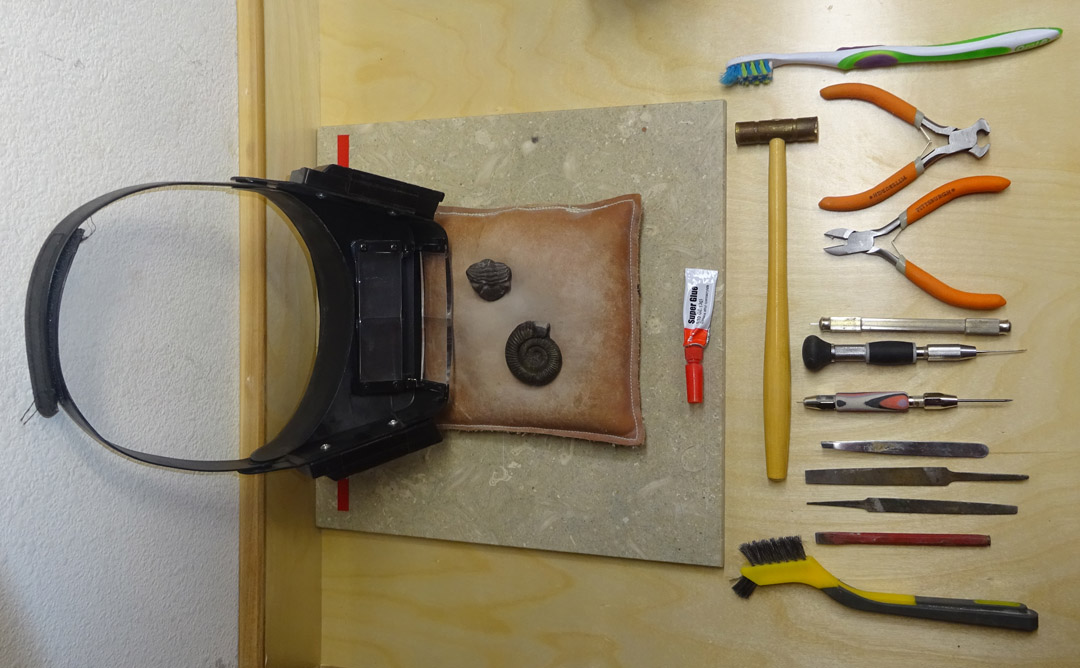
The Basics
I started with an assortment of small hand tools and a cheap headband magnifier. The pin vises are the only specialty tools I bought at the time.
In addition to an assortment of hand tools, a small rice filled specimen pillow is quite useful to hold the fossil still while picking at it.
Leather is a good choice as it sheds the dust and dirt more easily. I have several of them in different sizes. They are easily made by hand.

An Assortment of Pin Vises
Pin vises are a small hand tool with a clamping mechanism on the end that can hold a needle, straight pin or drill bit. They are often listed as "hand drills" on Amazon and eBay.
The prices range from $4 to $30 depending on quality. Try to avoid the ones with a large head as it limits the angle of attack and access to small spaces.
I use straight pins, sewing needles both hand sewing needles and machine needles in my vises. I keep a small honing stone handy as they all will dull with use.
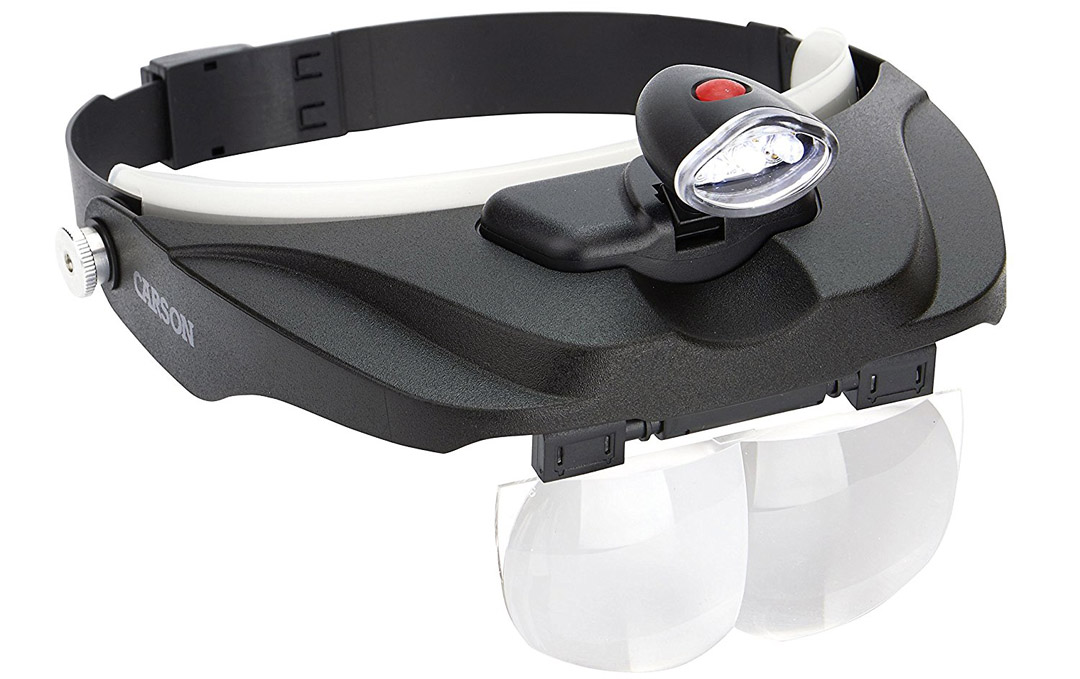
Headband Magnifier
A Headband Magnifier is essentially a dual magnifying glass that is mounted on a headband so that you can see the fossil with greater detail.
These come in a range of quality and price ranges. There are at least a dozen different models available on the internet. I have a set that I
I bought from Harbor Freight for about $9. They are equipped with little flashlights on each side but a desk lamp works much better for lighting.

Loupes
In addition to the headband, a few loupes are also useful. A wide range price and quality are available. Harbor Freight has a usable set of five for $3.99.

Hand Tools
All of these hand tools are inexpensive. You can never have too many brushes, chisels and files. Dental picks are also useful if you can find them.
The Next Step
In my opinion, the microscope is the first investment level tool you should buy. The microscope must be stereo and no more than 20X is ever
needed unless you are doing work on very small microfossils. In that case, a second microscopes for small stuff is probably the best choice.
There are a number of cheap Chinese made stereo microscopes now on the market. They're not terribly pricey and some include a USB camera.
Be careful about the "focal distance" of these microscopes. Some of them are almost 300 cm which is a pretty long distance from eyes to hands.
I opted to go with a used Bausch and Lomb Stereozoom. These are readily available on eBay as they are often surplus from the semiconductor
industry. I watched them on eBay for a few months and eventually was able to get a Stereozoom 4 with a nice boom stand for under $400 delivered.
* Be sure it includes eyepieces or is priced accordingly, new ones are about $60 for a pair.
* A boom type stand is very handy allowing a lot of room for the fossil. You could make your own stand if you are so inclined.
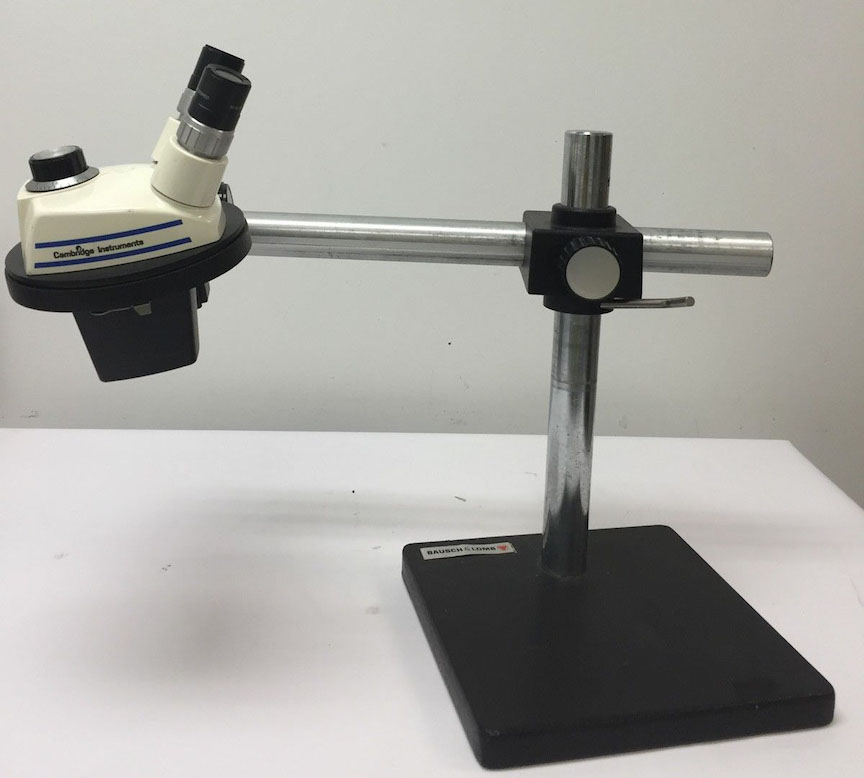
Example of a Suitable Stereo Microscope
Moving Up to Power Tools
Moving beyond hand tools can get to be a considerable investment. Almost all of the power tools are pneumatic so a compressed air supply mandatory to operate the tools.
The power tools create alot of DUST! So, you will need to work outside or you will need to build or buy a suitable dust removal system. Both of these are fairly complex.
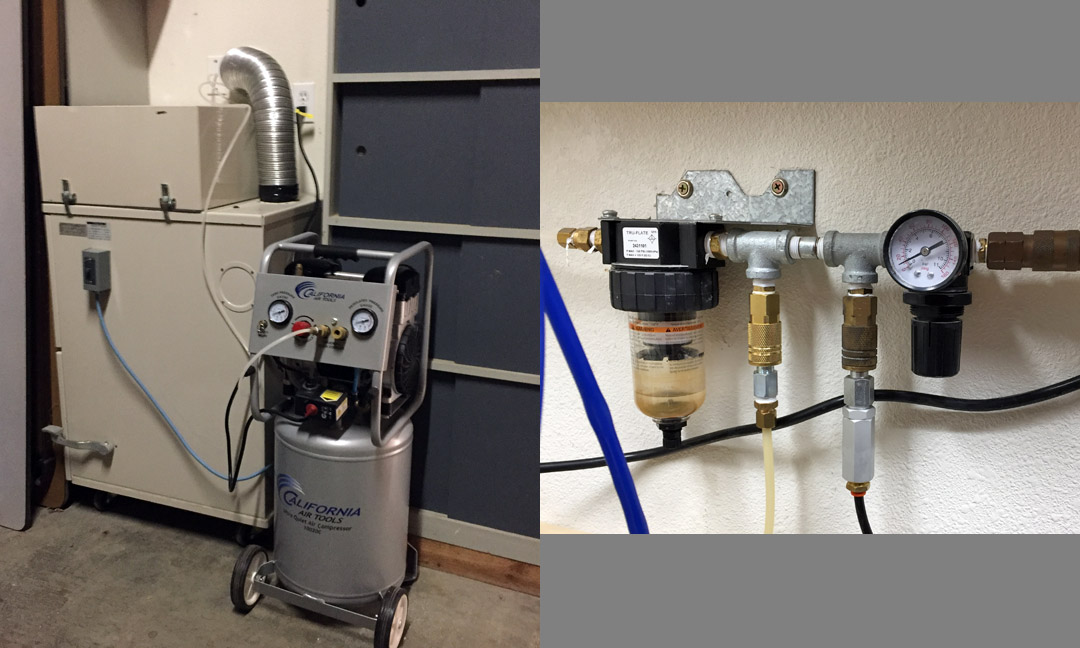
Air Compressor and Regulator Manifold
This photo shows my air compressor and also my dust collection unit. Sufficient dry and oil free air is essential for the proper operation of the air abrasive units and the
pneumatically operated air scribes. Bad air will damage your tools. I selected this compressor because it is very quiet, my neighbors cannot even hear it. It is so quiet, it
stays in the garage even during use. It has plenty of capacity to operate the tools and cycles about every 5 minutes. It was about $400 at the Home Depot and they have several
models available. The tank is 10 Gallons. The water separator and regulator manifold was built from parts available at my local hardware store. No special talent is required.
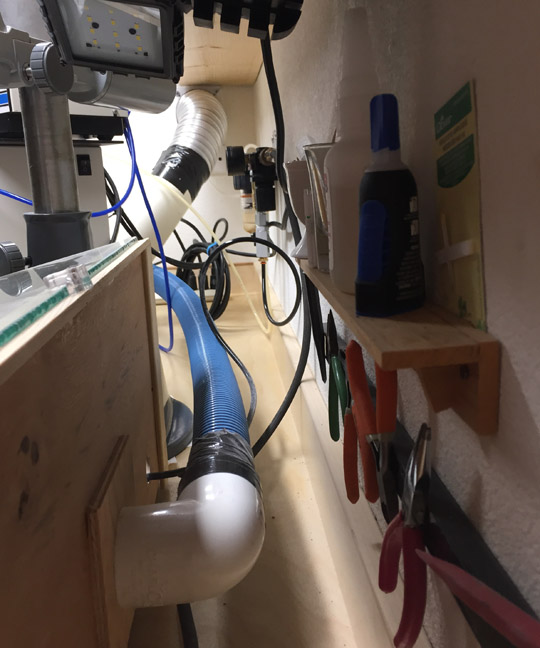
Dust Collection Piping
The dust collector is manufactured by COMCO, the same company who makes the Air Abrasive Unit. These are not cheap even when found as surplus, like I did.
I put a hole through the wall to connect the air abrasive work station to the dust collector so that the unit did not have to live in the lab room. It is not noiseless.
With a little creativity, I expect that a functional equivalent could be achieved with a fairly large shop vac and dryer hoses.
When I added the Chipping Box, I connected it to the suction line of the dust collector as the air scribes also create alot of dust.
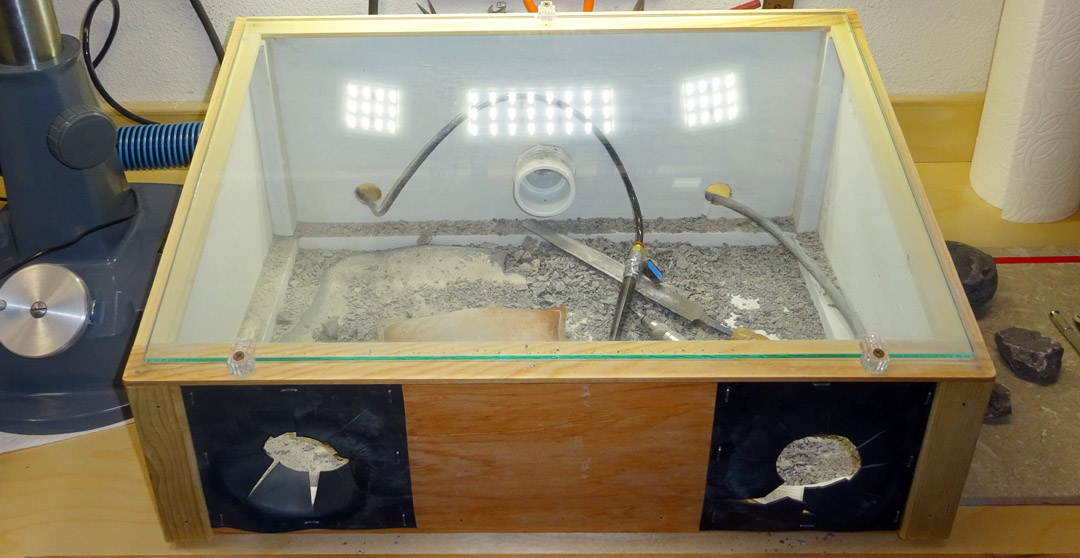
Chipping Box
When I attempted to work with my air scribes in the newly built lab, the dust quickly became an issue. I made my own chipping box from 1/4" plywood and is covered with
1/4" plate glass. Do not try plexiglass as it has an inherent electrostatic charge that ATTRACTS the dust and quickly makes it so dirty that you cannot see through it.

Air Scribe / Pen
Air scribes are the "workhorse" of fossil preparation. There are many manufacturers and several people who modify commercially made products to improve their performance as prep tools
I use a Ken Mannion "ST" pen for the roughing out work. I recently acquired the Paleo Tools MicroJack 2 for very fine work. Both pens work well for me. You cannot have too many pens.
Suitable pens can be had for as little as $100 to over $400.
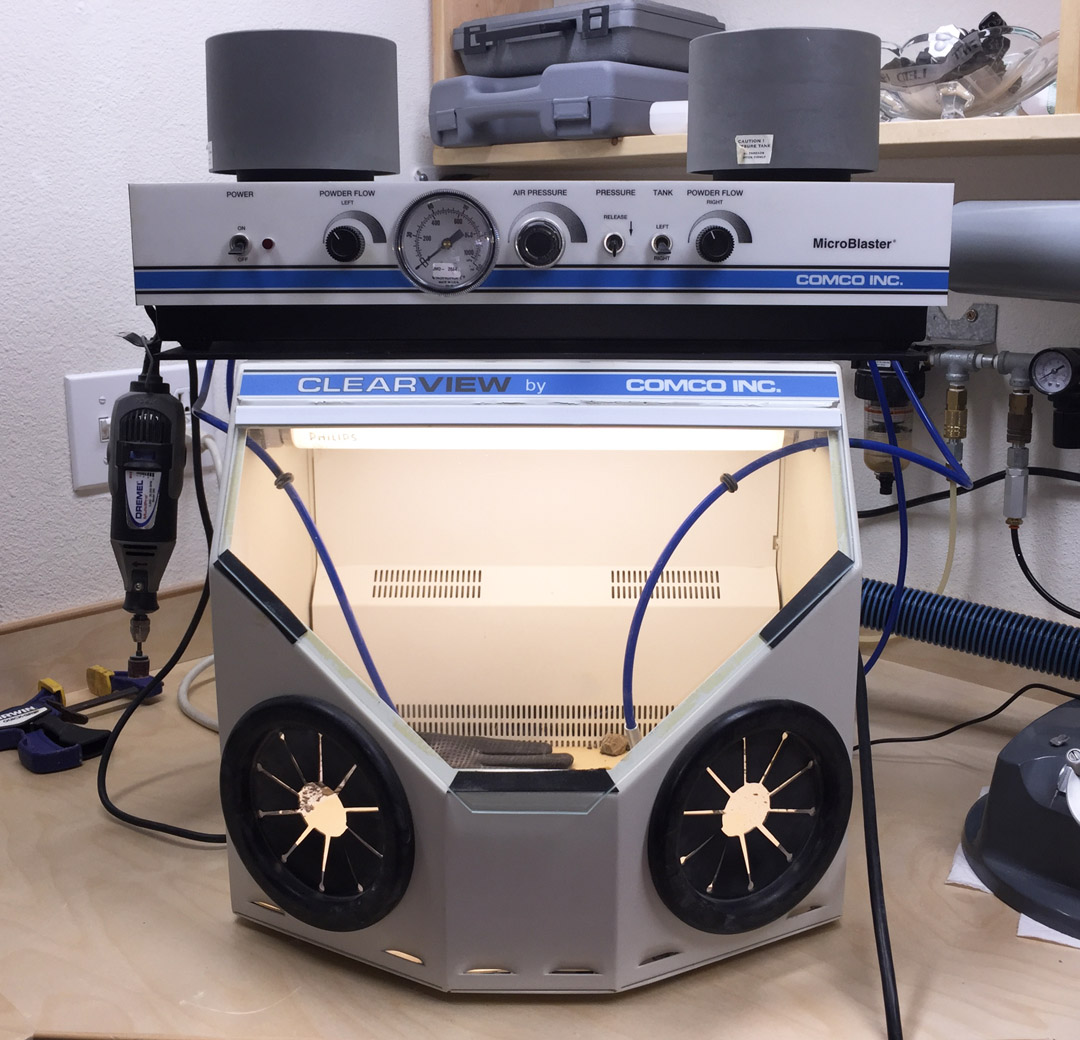
Air Abrasive Unit
I have a COMCO dual tank air abrasive unit that I bought as surplus from the semiconductor industry.
New ones are about $4000. The parts are readily available for COMCO which is one reason I chose it.

Ultrasonic Bath Cleaner
My most recent acquisition is a small ultrasonic cleaner. These are readily available on eBay from China for about $50. It does a great job on soft and loose matrix.
Questions? ... Send me an e-mail: tngray@nautiloid.net